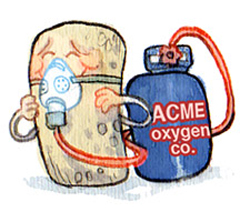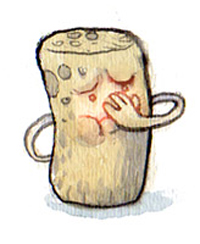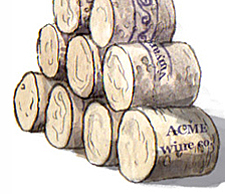

There is solid scientific evidence which demonstrates that corks are perfect enclosures for wine,
discounting TCA of course.
Please Stop Telling People
That Corks ‘Breathe’
Who would have thought that wine corks would be so controversial. The voluminous reader response to our features on the pros and cons of corking wine continues long after the articles have appeared. Our learned guest columnist, Richard Grant Peterson offers some empirical evidence to prove that corks have been used for ages because...they work.
by
Richard Grant Peterson, PhD
February 10, 2008
 ad to say, most articles about the pros and cons of using corks for closing wine bottles end up parroting at least one absolute untruth. Contrary to anything mystic that you may have heard, I can tell you categorically that sound corks do not breathe air.
ad to say, most articles about the pros and cons of using corks for closing wine bottles end up parroting at least one absolute untruth. Contrary to anything mystic that you may have heard, I can tell you categorically that sound corks do not breathe air.
I have published a simple statement to this effect many times over the years, hoping it would be memorized by all, but alas, here it is one more time:
I agree that it sounds glamorous to say, "closures 'breathe' at some mysterious rate which controls the process of bottle-aging precisely" (as if any winemaker ever knows exactly when each bottle of wine will be opened and can time the "aging" to match the consumer's whim). The problem I have with this old fable about corks breathing is that it’s pure B.S. It’s high time we stop seeing it reprinted.
We did the lab work almost five decades ago! It’s been repeated more than once in Australia and all those who’ve checked this in the lab tell the same story: Sound corks do not transmit oxygen! Even more important, neither is oxygen transmission through closures what we want! Wine aging and the development of 'bottle bouquet' during bottle age is anaerobic, never aerobic. The effect of continued aeration of wine in bottle is something quite different, and antagonistic to the development of bottle bouquet. Aeration of wine by a leaking closure does at least three things, in steps:
(1) It oxidizes and removes the SO2 protection from the wine, then;
(2) It oxidizes and removes the tannin, pigment and other polyphenolic protections from the wine;
(3) It oxidizes and destroys the flavor of the wine, followed closely by browning, polymerization of the oxidized pigment and other polyphenols, etc.
 This completes the oxidative destruction of what would have been a perfectly preserved bottle of fine wine if the closure hadn't leaked air into the bottle.
This completes the oxidative destruction of what would have been a perfectly preserved bottle of fine wine if the closure hadn't leaked air into the bottle.
(4) Separate from the above oxidation reactions, air, in the presence of certain bacteria, (which wine always has), allows them to grow in the wine and turn it from wine into vinegar.
I’d like to take the space here to answer one of the most prevalent questions I hear from the wine drinking public. There is a great deal of confusion about the 'good aeration' of decanting before drinking an old bottle of wine - and the 'bad aeration' that can lead to oxidation. Most people don't understand either one of them, but neither is very difficult.
First, you need to recognize something that most people have never thought about: Everything we eat or drink is bathed in air as it passes over our taste (& nose) receptors. We are used to whatever the taste of air in food and drink is. We like it. But old wine is not like most foods that we eat or drink, at least not when the bottle is first opened. Old wine has been sealed up inside a bottle for many years and something changes during that time. The wine is no longer ‘bathed in air’ and it will taste funny at first, until we bathe it in air before drinking. We live in a world of chemistry and that is sometimes confusing. You see, old wine has been living in a ‘reducing atmosphere’ in the sealed bottle, which is the chemical opposite of aeration (an aerated atmosphere).
Do not misunderstand: Aeration is not the same as oxidation.
 When you aerate an old wine, you mix air into it and that makes it easy to drink and enjoy. Trust this for a minute and it will become clear. Freshly dissolved air doesn't oxidize the wine immediately - it cannot, until it has had time to do so. The oxidation of wine by dissolved oxygen takes place slowly and you won't see the effect for several hours after aerating, maybe even overnight.
When you aerate an old wine, you mix air into it and that makes it easy to drink and enjoy. Trust this for a minute and it will become clear. Freshly dissolved air doesn't oxidize the wine immediately - it cannot, until it has had time to do so. The oxidation of wine by dissolved oxygen takes place slowly and you won't see the effect for several hours after aerating, maybe even overnight. Once a wine has become oxidized, it is dead and cannot be revived because the oxygen has attacked flavor and other components of the wine and changed them into something other than wine flavor. Think of an aerated wine as simply mixed with air, where the air hasn’t had time enough to attack and oxidize the wine as yet. Your job is to drink the wine while it is aerated but well before it could get oxidized.
In graduate school wine research, one of the enduring chemical truths I learned from a genuine master, Professor Maynard A. Joslyn, was that "Wine in a closed container quickly becomes ‘reducing’ on its own (accept this chemical term for the moment), and wine lives naturally in a ‘reducing atmosphere’ in sealed barrels, tanks or bottles." That is extremely important to know if you want to understand bottle aging.
I've opened many bottles of 30+ year old Cabernet wine and, nearly always, those wines have a 'reducing funk' at the time they are first opened. There is no H2S - they aren't "reduced" in that sense, but only living in a ‘mildly reducing’ atmosphere. They just don’t smell right at first. All they need is to be decanted to remove solids, if present, and then aerated by being poured, with splashing, back into the (rinsed) original bottle. Then allow the wine to stand in its now aerated state for another few minutes before serving.
The reducing funk disappears for good reason: We are used to whatever the taste of air in food and drink is. We like it and we want to drink our wine mixed with air, same as any other food or drink. Since old wine has been sealed up inside a bottle for thirty years in a ‘reducing atmosphere’ - the chemical opposite of aeration - we have to get it into an aerated atmosphere before drinking. All we have to do to bring out the goodness of the wine’s aroma and bouquet is aerate a little to re-establish the aerated surroundings we want to taste it in and, presto, decanting does the trick.
I tell you this so that even non-chemists will understand the truth that wine aging never takes place under aerated conditions. It's because those are the conditions that will lead only to oxidation in time, and destruction of the good things in wine. In a perfectly sealed bottle, the wine will not oxidize but will develop bottle bouquet - which it cannot do if that #%$&@! destructive oxygen is present.
 Okay, I’m a realist. I know that some people are going to continue defining "wine aging" as 'slowly oxidizing it until the wine isn't drinkable any more', if they want to. That's what those idiots do when they promote deliberate oxidation of your wine through selectively defective closures, although I don't think they do it on purpose - it's just that they lack chemical common sense.
Okay, I’m a realist. I know that some people are going to continue defining "wine aging" as 'slowly oxidizing it until the wine isn't drinkable any more', if they want to. That's what those idiots do when they promote deliberate oxidation of your wine through selectively defective closures, although I don't think they do it on purpose - it's just that they lack chemical common sense.










 READER FEEDBACK: To post your comments on this story,
READER FEEDBACK: To post your comments on this story,




